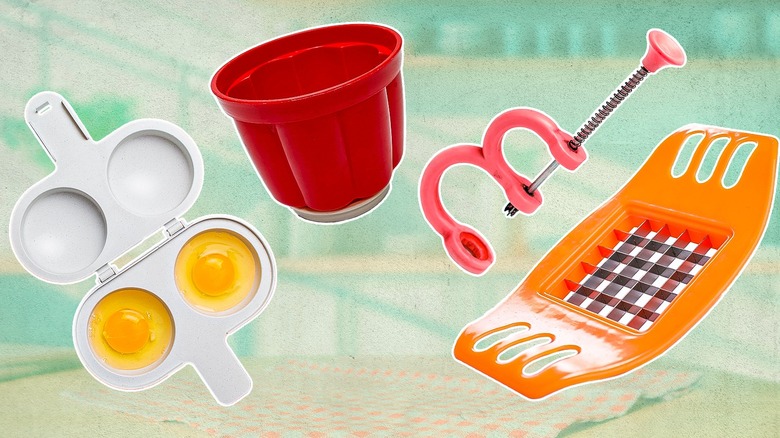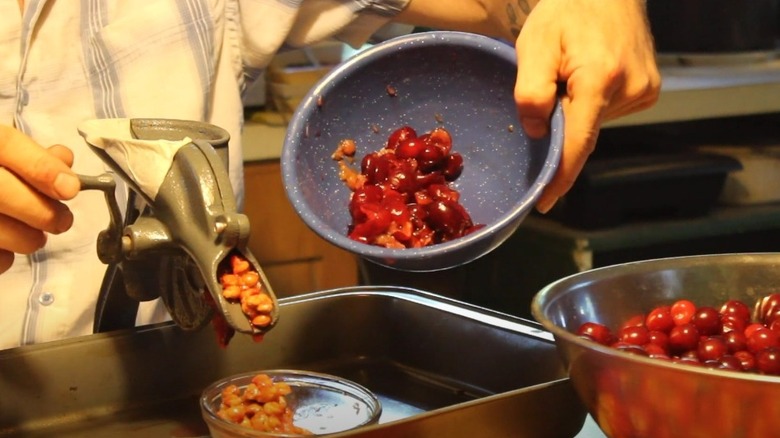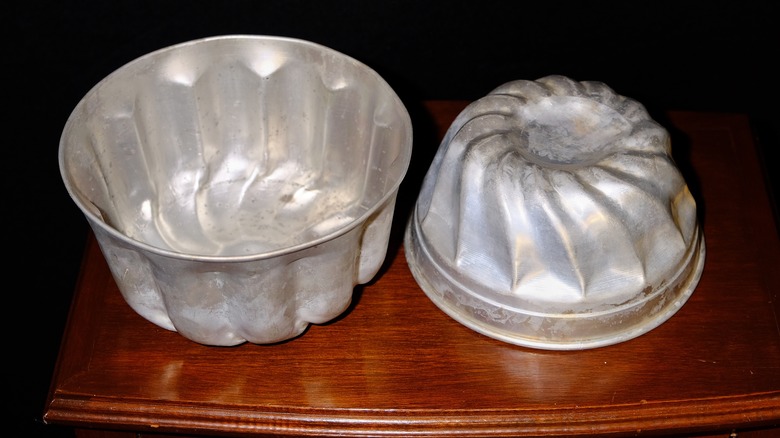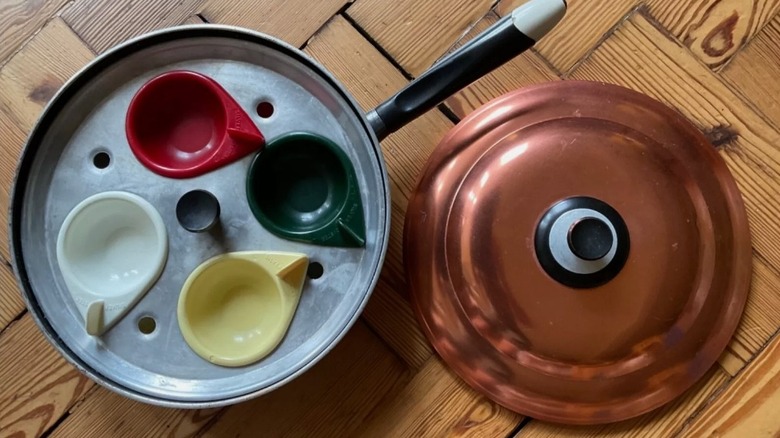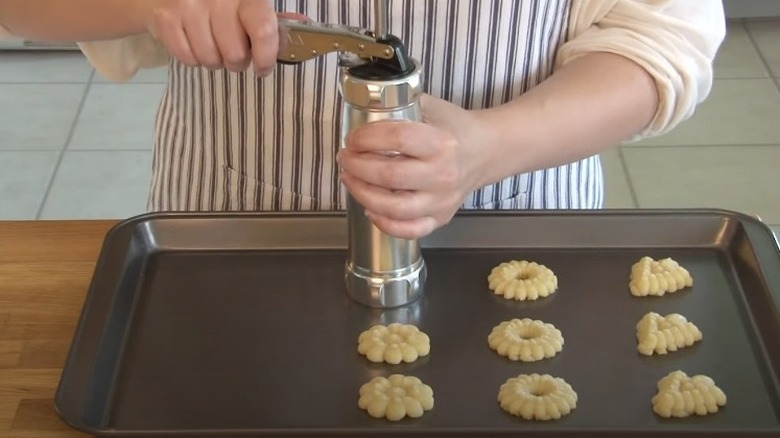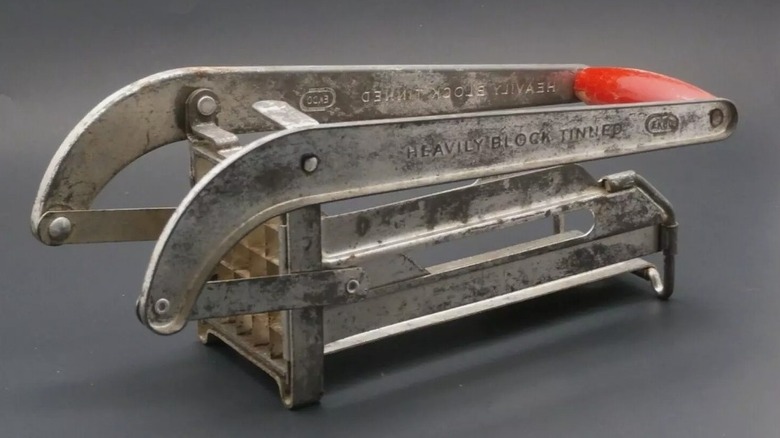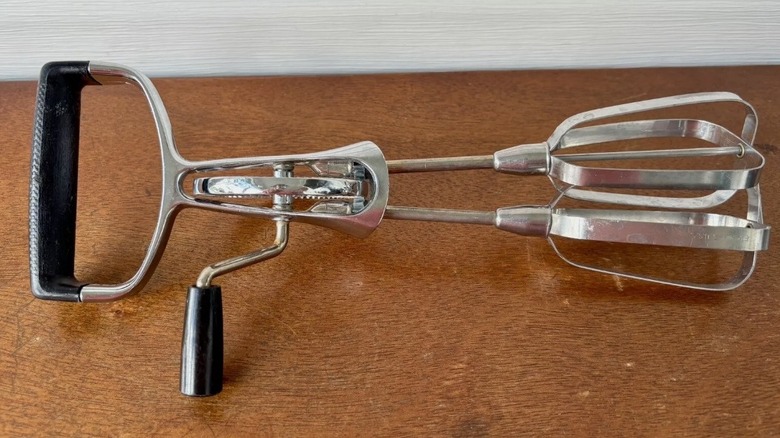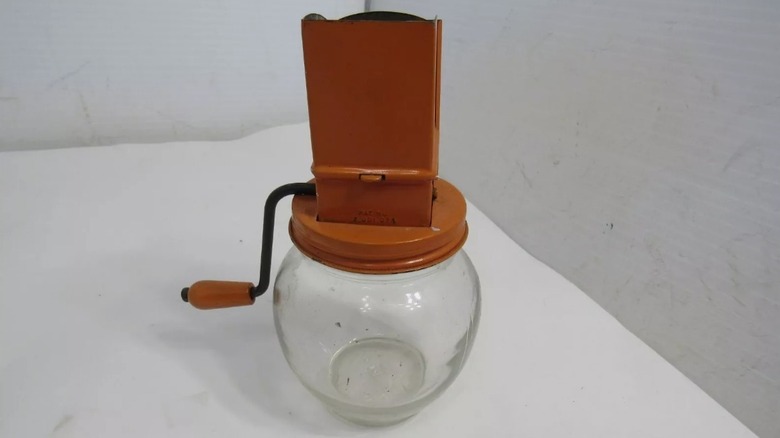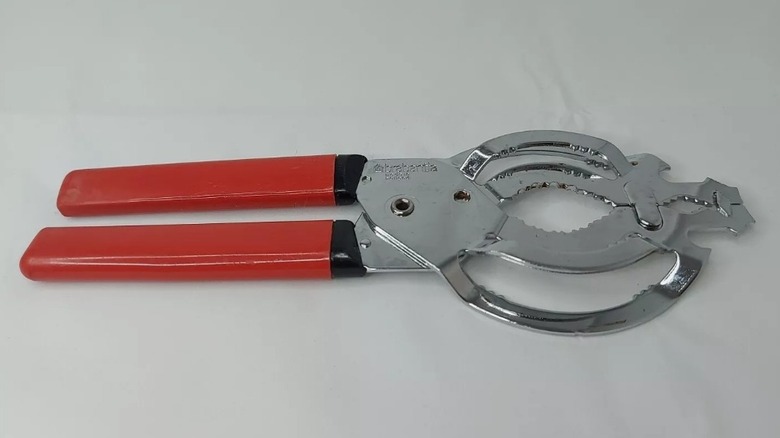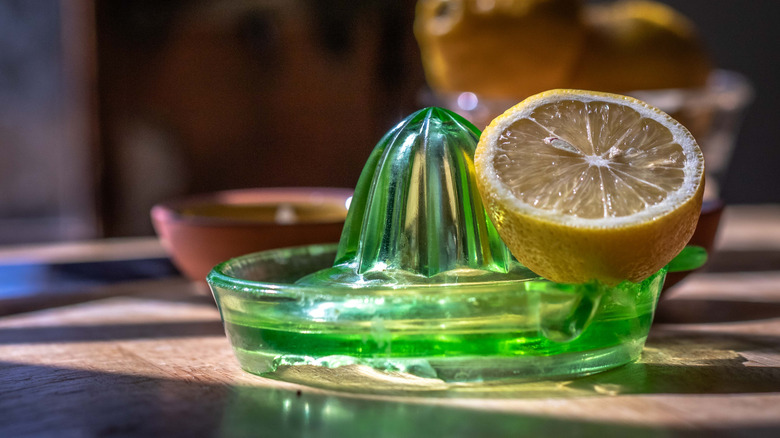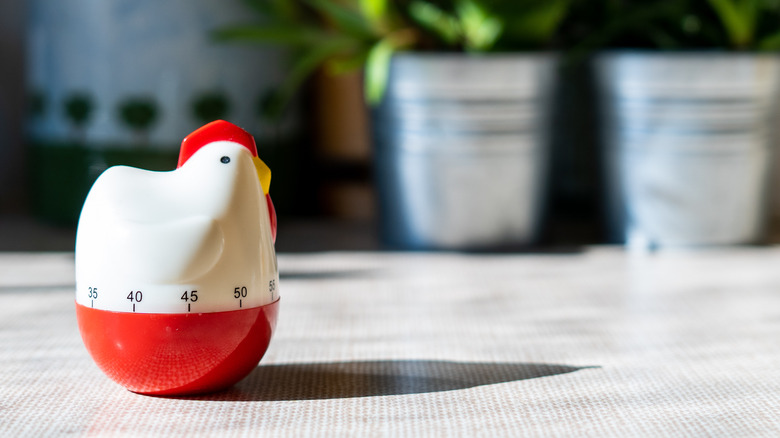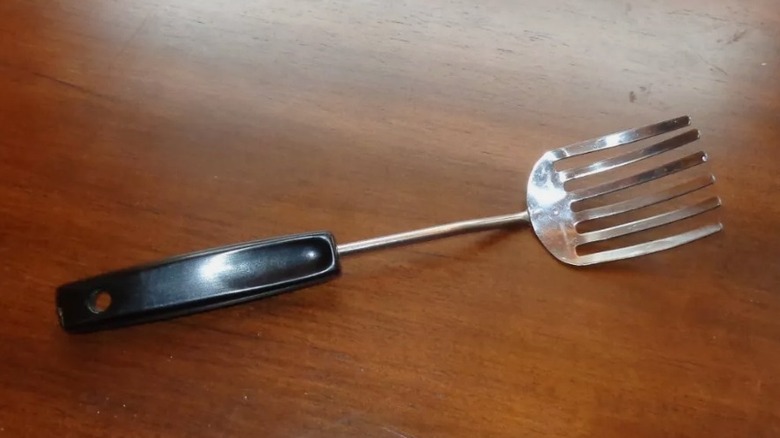Forgotten Kitchen Tools That Changed The Way We Cook
If you're anything like us, you love trying out a new kitchen gadget. Anything that can streamline and simplify the cooking or baking process is a must-have in our kitchens, from powerful food processors and air fryers, to digital scales and ice cream makers.
Before the days of modern technology, people were still seeking out ways to make their kitchen preparations more efficient. Though the solutions they came up with may seem a little less high-tech than the products available to us today, they still served as incredibly effective tools, making tasks easier and expanding what home cooks could achieve. In fact, it was many of these seemingly simple gadgets that paved the way for today's innovations, and we'd argue that some of them are still worthy of a place in our kitchens.
We've rounded up some of our favorite old-school kitchen tools, that whilst aren't commonplace in our homes anymore, still serve a notable purpose. Many of these tools are still available to buy, whether that's in the form of a vintage second-hand purchase, or a modernized version of the original. From egg poachers to nut grinders, let's rediscover some of these nostalgic tools, and give the creativity and craftsmanship that went into them a little appreciation.
Cherry pitter
The first tool on our list might look a little scary, but it's sure to save you a significant chunk of time if you're a fan of cherries. The cherry pitter, thought to have been created in the late 1800s, was designed to remove the pits from cherries quickly and effortlessly. Before this invention hit the market, removing pits from cherries could be a time-consuming and messy task, but owners of the cherry pitter could benefit from dramatically simplified preparation when it came to making cherry pies, jams, and other cherry desserts.
The classic cherry pitter is a fairly large, metal contraption, that can be clamped to the edge of a table or worktop. The cherries are first loaded into an opening in the top of the pitter, then a handle is turned which drives the fruits towards a blade which slices the cherry open and separates the flesh from the pit. It's a simple but highly effective mechanism that allows for speedy processing of large quantities of cherries, without squashing the fruit.
Handheld cherry pitters were also popular, though these can typically only hold one cherry at a time, which makes the pitting process a little less swift. Today, both types of pitters are still available to purchase, though these tend to be smaller and lighter than their vintage counterparts and typically made from plastic.
Jelly molds
Used to shape jellies into impressive, decorative designs, the jelly mold was once a common fixture in kitchens. This tool was first put to use in the 17th century, when it often came in a tall, conical shape. And, it wasn't just jelly that was used to fill these molds. They could be used to shape all kinds of desserts, such as blancmanges, puddings, and pies, as well as savory foods like potted meats.
Throughout the years, jelly molds were made from a variety of materials, such as copper, aluminum, or glass, coming in a range of intricate designs, from castles to animals. Their popularity grew alongside the invention of commercial powdered gelatin in the mid-1800s, which made set desserts more accessible to the average household. The 20th century saw the boom of the Jell-O salad, where whole chunks of fruits and veggies were set into a flavored jelly. These molds also gave savory dishes a touch of elegance, like Jell-O's savory cousin aspic – a type of thickened meat broth that becomes gelatinous when cooled.
Today, jelly molds are not as commonly used. Despite this, you can certainly still find them on the market, now typically made from lightweight and convenient materials like plastic or silicone. Vintage jelly molds have now become somewhat of a collector's item, with many beautifully ornate designs doing the rounds at antique stores and flea markets.
Egg poacher
We all know that poaching eggs can be a tricky process. Should you swirl the water in the pan? Should you add vinegar? How do you achieve the perfect shape? Well, enter the humble egg poaching device, which will remove all of these worries, and deliver perfectly formed poached eggs every time.
Traditional egg poachers typically consist of a metal pan with individual cups or compartments to hold each egg. The poacher is placed over simmering water, allowing the steam to gently cook the eggs. Since the eggs are poached directly in water, the need for employing other techniques to help them maintain their shape is eliminated. Using the egg poacher will give you perfectly rounded, uniformly shaped eggs with tender whites and runny yolks.
Whilst perhaps not a staple in everyone's kitchen, egg poachers are still available in stores and from online retailers. They come in various designs, from the classic stovetop models to microwave-friendly options, as well as individual cups that simply float in simmering water.
Cookie press
Perhaps one of the most charming amongst these forgotten tools is the cookie press. Designed to create intricately shaped cookies with ease, this gadget allows bakers to produce beautifully decorated treats that are perfect for holidays, parties, or simply to satisfy a sweet tooth. The invention of the cookie press opened up a whole world of creativity for home bakers who didn't want to spend hours on end hand-crafting cookies into whimsical shapes.
The basic design of a cookie press includes a hollow tube or barrel fitted with a plunger mechanism. At the end of the barrel, interchangeable discs or plates feature various cutout patterns, such as stars, flowers, and swirls. To use a cookie press, bakers fill the barrel with soft cookie dough and press it through the patterned disc onto a baking sheet. And just like that, you have beautiful, detailed cookies, that can be left as they are or adorned with extra decorations.
Spritz cookies, which get their name for the German word "spritzen" (meaning to spray or squirt) are a popular holiday treat typically made with a cookie press. These buttery, crumbly cookies are pressed into pleasing designs, before being decorated with icing, chocolate, or sprinkles as desired.
French fry cutter
Say goodbye to fiddly, time-consuming potato slicing. If you want a whip up a batch of crunchy french fries, there's a tool that can save you a whole lot of time and effort. The french fry cutter revolutionized the way we prepare this beloved food, dramatically simplifying the process of cutting potatoes into uniform strips, ensuring consistent size and shape for even cooking.
Typically, a french fry cutter consists of a sturdy base and a lever mechanism equipped with a grid of sharp blades. By placing a potato in the cutter and pressing the lever, the potato is pushed through the blades, resulting in perfectly cut fries in one swift motion.
It's thought that the french fry cutter was invented in the early 1930s, and today it remains a staple in many commercial kitchens. As well as the manual cutters, specific french fry blades can now also be fitted to electric food processors for speedier slicing. Plus, these cutters can also be used for slicing other vegetables into thin sticks, like zucchinis, carrots, or sweet potatoes.
Hand-crank beaters
When it comes to baking light, airy cakes, making a batch of homemade whipped cream, or prepping your eggs for scrambling, the tool you use for beating the mixture is crucial. Electric mixers and whisks can be found in many of our kitchens, cherished for their ease of use, and the way they can elevate our recipes. But, before the days of these modern gadgets, a far more simplified, hand-held version was the tool of choice.
Hand-crank beaters are relatively small, manual devices that were essential for tasks such as whipping cream and mixing batter. With their simple yet effective design, hand-crank beaters helped home cooks to achieve light, fluffy textures and smooth, well-blended mixtures. Invented in the mid 1800s, the design of a hand-crank beater typically includes a set of rotating metal beaters attached to a handle and a crank mechanism. By turning the crank, the beaters spin in unison, creating that all-important whisking action. This offered a more efficient alternative to traditional whisks and forks. One of the most popular early uses of the hand-crank beater was whipping up egg whites, which had previously been deemed a rather arduous task.
Manual kitchen scale
Scales are an essential tool when your recipe requires the exact measurement of ingredients, and today there are a range of highly precise, battery-operated digital scales on the market. But, before the widespread availability of such scales, manual devices reigned supreme. With their simple mechanical nature, the manual kitchen scale provided home bakers with an accurate way to measure ingredients by weight.
Featuring a platform or bowl for holding ingredients and a dial for reading measurements, manual kitchen scales operate without the need for electricity or batteries. They generally use a spring mechanism, where the force exerted on the spring allows converted into a unit such as grams or ounces, which allows you to gauge the weight of the ingredients. The manual kitchen scale has been especially valued in baking, where precise measurements are often essential for perfecting the texture and flavor of cakes, pastries, and breads.
Now, with the rise of the digital kitchen scale, measuring ingredients is easier than ever. There's no need to rely on interpreting the dial, with electronic displays showing clear and precise measurements, that can be converted into other units with the press of a button. But, we have to argue that there's still something rather charming about using the retro manual variety.
Nut grinder
When tasked with finely chopping nuts, some of us opt for the manual route, grabbing a cutting board and a sharp knife, whilst others make use of a food processor. But, in days gone by, using another contraption was the method of choice. The nut grinder is a handy kitchen tool that can chop nuts into small, uniform pieces, making it easier to incorporate the delicious flavor and texture of walnuts, pecans, almonds, or whichever nuts you fancy into a variety of recipes.
This tool has its origins in the 1930s, and it also served other uses in the kitchen, such as grinding whole spices, or making breadcrumbs. The grinder consists of a sturdy glass receptacle, which acts as a chamber for holding the nuts or other ingredients once chopped, with a metal hand-crank chopping mechanism on the top, that rotates a set of blades. As the crank is turned, nuts are fed through the chamber and chopped or ground to the desired consistency. The resulting tiny pieces are perfect for adding to cakes and brownies, scattering over salads, or making a nut roast.
Jar opener
We've all experienced the frustration that comes with a particularly stubborn jar lid. You've given it all your might, you've tried the tea towel trick, but it still isn't budging. That's where the good old jar opener can come to the rescue.
This device is a simple yet incredibly valuable kitchen tool that has helped countless home cooks tackle a tightly sealed jar of pickles or pasta sauce. It's especially useful for those with limited strength or mobility, making the task far more effortless. Jar openers come in a few different designs, from basic rubber grips to metal devices with two long handles and a set of rounded, gripping teeth that fit around the lid of the jar. These tools provide the leverage needed to break the seal and twist open even the most tightly secured lids.
If you think a jar opener could be a game changer in your kitchen, you shouldn't have trouble finding one in a cookware store or from an online retailer. Modern models tend to be a little more ergonomic, and made from lighter materials like plastic. You can even find automatic, battery-operated versions, which offer a fast and hands-free way to crack open a jar.
Lemon squeezer
When making a homemade lemonade or lemon meringue pie, getting every last drop out of the fruit it essential, and doing this with your bare hands can be a challenge. To make this task a breeze, a lemon squeezer is all you need. This classic kitchen tool has simplified the process of extracting fresh juice from lemons, limes, and other citrus fruits, and it's been a staple in kitchens for generations.
The two most popular forms of this device are the tabletop squeezer, and the handheld squeezer. The tabletop version consists of a small rimmed dish, typically made of glass or plastic, with a conical, ridged prong in the center. The idea is to slice a lemon in half, and push the flesh firmly against the prong, causing the juice to be released and caught in the dish below. Handheld squeezers are usually designed with two concave halves connected by a hinge. The user places a halved citrus fruit inside and presses the handles together, forcing the juice through small holes while trapping the seeds and pulp. Using these tools is an excellent way to yield a generous amount of juice with minimal effort, allowing you to quickly and easily enhance your recipes with plenty of fresh citrus flavor.
Egg timer
Next up we have an iconic kitchen tool that was once instrumental in achieving perfectly cooked eggs. Before digital timers came onto the scene, using a manual egg timer was a reliable method for timing the boiling of eggs to achieve the desired level of doneness.
The traditional egg timer is usually a form of a sand timer, also known as an hourglass — two connected glass bulbs, connected by a thin tube, with sand inside. When the timer is flipped, the sand flows from one bulb to the other over a specific period of time, depending on the size of the timer. Despite being an accurate way to measure time, it's essential to keep an eye on the device so you know when the time has elapsed.
It wasn't until 1926 that the mechanical egg timer was invented, which made keeping track of time far easier with its audible cue. These small, spring-driven devices have a dial that's twisted to set the desired time. After the timer has counted down, a bell rings or a buzzer sounds when the time is up, signaling that the eggs are ready. In the modern day, we now have digital timers built into just about all of our devices, from our phones and smart speakers to the ovens themselves. Sadly, this has made the humble egg timer somewhat redundant, but we think they still make a wonderful decorative item.
Foley fork
At first glance, the Foley fork might look like any ordinary fork, with a few extra prongs for good measure. But, this kitchen tool is surprisingly versatile. Despite being a rare sight in kitchens today, it once served multiple purposes in home cooking, particularly during the 1930s, with its unique design combining the functions of a fork, masher, and whisk.
The head of the Foley fork resembles a traditional fork but features six wide, flat, curved prongs. It has a long, sturdy handle for extra leverage and tends to be made from durable stainless steel. This design allows the tool to perform a variety of kitchen tasks with ease. Some popular uses for the Foley fork included mashing potatoes, whipping eggs, making pastry, and mixing anything from cake batters to gravies. Due to its wide shape, you can also use the fork to scoop up foods for serving and flip items during pan-frying.
Though the original Foley fork is no longer manufactured, there are many replicas available. These are often referred to as "granny forks" or "blending forks," and will serve you just as well as the classic version.
